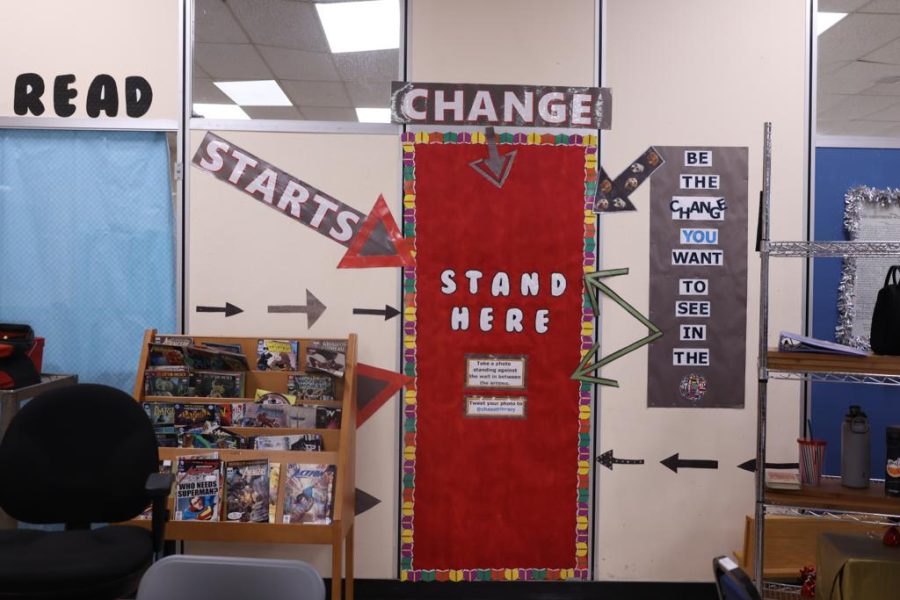What will fill the shelves?
May 16, 2023
As school libraries evolve to survive in the digital age, one major question remains for their future: how central of a role will books continue to play? Will they get the current, $14,000 per year treatment? Will they become a smaller piece of the puzzle? Or will other forms of “media” come to dominate libraries and media centers entirely?
Silverstein and other pre-high school librarians are working to ensure that books remain at the center of libraries’ work and purpose, along with new additions like digital resources. One such librarian is Kim Laskey, who works at Cherry Hill’s Joseph D. Sharp Elementary School and said she was “cautiously optimistic” about libraries’ role in the future of education.
“At the elementary school, they still get excited about a book,” Laskey said.
Books and other physical resources still do not dominate the budgets at schools like Sharp. Digital resources cost roughly $7,000 out of a $10,000 overall budget per year; hard materials round out the remaining spending in Laskey’s budget, which she said has slightly decreased from past years. But, as far as the kids are concerned, books remain a big deal at the elementary level.
Laskey described kids approaching her on the way to their school buses and telling her about their love for a book her library had lent them. Such lending occurs often and in great numbers: Laskey estimated that the Sharp library’s circulation is around 400 books per week.
It’s not just book check-outs that remain alive and well with younger kids, either. Library skills, such as analyzing maps and using the Dewey Decimal System, remain priorities for elementary educators.
“Those are very important and there’s no other place to get those kinds of skills,” Laskey said.
The priorities look different, however, at the high school level. There, a stark contrast exists in terms of both circulation and education. High school students might check out 400 books in an entire school year at East, while their younger siblings churn through that amount in one week. Meanwhile, they might receive a lesson from the media center on virtual reality or digital presentation tools, while elementary students grasp the basics of library usage. Such differences reflect the various needs and focuses of students in different age groups.
“I think there’s a difference with how children, how students, the people of your generation, are coming up in terms of how they’re accessing information,” Meloche said.
Within the educational differences at various levels lie some major questions: where do libraries go from here? What will fill their shelves when there are such wide varieties of student needs, experiences, and desires regarding the library? Will elementary and high school libraries become totally different-looking entities? Where does that leave public libraries, then?
If any answers to these complex questions exist, they might be rooted in compromises.
“I will tell you my honest feeling is I’m not as concerned with what kids read or what people read, as long as they are reading,” Meloche said.
He, along with other educators, sees a future in which kids are still reading, of course — just maybe not in the same way they used to. Reading articles online, engaging with digital encyclopedias, and also returning to old-fashioned books at times could all blend together to create the future to which libraries will have to adapt.
In such a future, libraries can maintain a vital role. More than ever, the information students consume is subject to controversies and contradictions that increase complexity. From decoding misinformation to dodging unreliable sources, a new set of library skills — one that is more about analyzing information, rather than simply finding it among the shelves — could emerge.
Those shelves might be full of books. They might be focused on accessing resources digitally. They might evolve to contain something else entirely. But here in Cherry Hill — and, if many educators have their way, in schools and communities everywhere — libraries will persist. They will overcome their struggles and they will provide vital resources to the people they serve.
“The library is often the beating heart of the school, the center in so many ways: academically, in terms of thinking, in terms of learning. It’s a place where children have the opportunity to truly be free and to be themselves, to explore information, to look up new things, to try new things, to find out how to access material and how to discern whether material is accurate or beneficial or valuable. I think the libraries are just a very special place,” said Meloche.
With the backing of administrators, the support of educators, and the adaptability of their caretakers, these “very special places,” as Meloche described them, seem poised to overcome their struggles, at least for now. But, in the long-term, will libraries remain special enough to maintain their place in an ever-evolving world?
Only time will tell.
This article, a piece of long-form journalism, was produced over the course of several months as part of Aiden Rood’s independent study project, titled “American High School,” which aimed to analyze national issues in education through the lens of those issues’ role at Cherry Hill High School East, a large, suburban high school in Cherry Hill, New Jersey.
Enis Ercan (‘24) contributed digital support for this project.
